

The Federal Government Shutdown
Virginia’s safety net feels the strain of funding disruption in Washington
By Meredith Young, MSNP, and Lauryn Walker, PhD. Published October 17th, 2025.
Related Content

What Triggered the Shutdown?
When Congress failed to pass a funding bill by midnight on October 1, 2025, discretionary federal funding lapsed, forcing many agencies to halt or scale back operations. While essential functions tied to mandatory funding (such as Medicare, Medicaid, and Social Security) continue, agencies that rely on discretionary appropriations must pause or limit non-essential activities until new funding is enacted.
What’s Disrupted
The result is a federal government shutdown that affects regulatory, grant, and oversight activities across the country.1 In a September 30 report on the potential effects, the Congressional Budget Office estimated that about 750,000 federal employees could be furloughed (or placed on unpaid leave) each day.2
Why it Matters
When federal discretionary funding lapses, states and localities face uncertainty and operational strain, as many state-administered programs rely on federal grants or partnerships. Some programs may continue to operate temporarily by using advance appropriations or unspent funds that have been carried over, while others may halt activities once funds are exhausted.
As a shutdown continues, uncertainty may grow around state budgeting, agency decision-making, and coordination with federal partners that provide critical funding and oversight.3, 4
CMS Temporarily Holds Medicare Physician Payments
Amid the ongoing federal government shutdown, the Centers for Medicare & Medicaid Services (CMS) briefly announced a pause on all Medicare payments to physicians on October 15, 2025, only to reverse course within hours.5 The initial directive instructed Medicare Administrative Contractors to temporarily hold all claims under the Physician Fee Schedule, ground ambulance transport, and Federally Qualified Health Centers (FQHCs) for services on or after October 1.6 CMS later clarified, however, that payments would continue as usual for most providers and that only claims tied to expired authorities, such as certain telehealth and hospital-at-home services, would be affected. The agency emphasized that no payments have been delayed and explained that some pandemic-era telehealth flexibilities (see below), like coverage for services delivered in patients’ homes or outside rural areas, have lapsed under pre-COVID statutory limits. CMS advised clinicians whose services may no longer be covered to provide beneficiaries with an advance notice of noncoverage.7
Telehealth and Clinician Services
The expiration of COVID-19–era telehealth flexibilities on October 1, 2025, has triggered what some are calling a “telehealth cliff”.8 Multiple Medicare waivers and statutory expansions that enabled broader virtual care were tied to legislative extensions; with no new extensions enacted, many of those flexibilities have now ended (see Table 1).8
This table was adapted directly from Cohen, A.M, et al. (2025).6
These programs are critical to Virginia’s health and safety net, providing essential services to vulnerable populations. As described above, the current lapse in discretionary federal funding is already disrupting Medicare telehealth flexibilities, hospital-at-home programs, and key grant-supported initiatives, creating the potential for operational and financial strain on clinicians and providers. Table 2 (below) highlights additional programs affected by the current shutdown, their purposes, and how they are being impacted, providing a snapshot of the challenges facing Virginia’s safety net and health system.
A Case Study on the Potential Impact of a Federal Shutdown
Community Health Centers in Virginia
Community health centers (CHCs), including Federally Qualified Health Centers (FQHCs), are a critical lifeline for low-income and medically underserved communities in Virginia. Nationally, Health Resources and Services Administration (HRSA)-funded health centers serve over 32.4 million people across roughly 1,400 grantees and 16,200 sites, providing primary care, preventive services, behavioral health, dental care, and other essential supports.
In Virginia:
- 31 Federally Qualified Health Centers (FQHCs) operate across more than 200 sites, including rural and medically underserved areas16
- Nearly 90% of patients live at or below 200% of the federal poverty level17
- Reported $543 million in total costs in 2024, averaging about $1,315 per patient18
- Virginians also supported by 84 Rural Health Clinics (RHCs)19
FQHCs are a subset of Community Health Centers (CHC) that meet federal requirements to receive enhanced reimbursement and grant funding, whereas CHC is a broader term encompassing FQHCs and other nonprofit clinics that provide comprehensive, affordable primary care. For many Virginians, CHCs are the primary, and often only, access point for essential health services.
A few potential impacts of the shutdown may include:
- Financial Strain: Many CHCs rely on discretionary federal grants, such as HRSA Section 330 funds, for core operations including staffing, outreach, case management, facilities, and capital.20 Pauses in funding can create immediate challenges in meeting payroll, rent, utilities, and contractual obligations, particularly for organizations with minimal reserves or limited access to credit. Even short-term disruptions could likely jeopardize service continuity in rural or underserved areas.
- Workforce Morale and Turnover: Uncertainty and resource constraints may strain staff, erode morale, and increase the risk of turnover.21 Clinicians, providers, and staff could leave for more stable employment, making recruitment to underserved regions even more difficult. Loss of experienced staff and institutional knowledge could have lasting effects on program recovery and quality of care.
- Service Disruptions: Lapses in Medicare telehealth flexibilities, hospital-at-home programs, and other COVID-19-era policies can limit access to care, especially for rural patients or those with mobility challenges. Programs like Medicaid DSH, WIC, and other discretionary grants may also be delayed, compounding operational stress for CHCs.
Organizations such as the Virginia Community Healthcare Association (VCHA) play a central role in coordinating advocacy, training, and provider recruitment during federal funding pauses. The Commonwealth could consider temporary bridging grants, low-interest loans, or other stopgap supports to sustain operations and prevent service interruptions while federal funding resumes. However, the full scope and duration of these impacts remain to be seen and will depend on how long the funding lapse persists and the speed of federal recovery efforts.
The Bottom Line
The current federal shutdown is not an abstract fiscal standoff; it’s a stress test on Virginia’s health and healthcare infrastructure. Health systems, community health centers, clinicians, and safety-net leaders across the Commonwealth are already bracing for cascading impacts: frozen grant flows, shrinking services, stressed staff, and worsening access for vulnerable communities.
For safety-net providers and clinicians across the Commonwealth, the imperative is urgent: protect operations, preserve the current workforce, shore up finances, and advocate forcefully.
For states and federal policymakers alike, the deeper lesson is clear: access to critical services and care can’t be left vulnerable to shifting budget politics.
